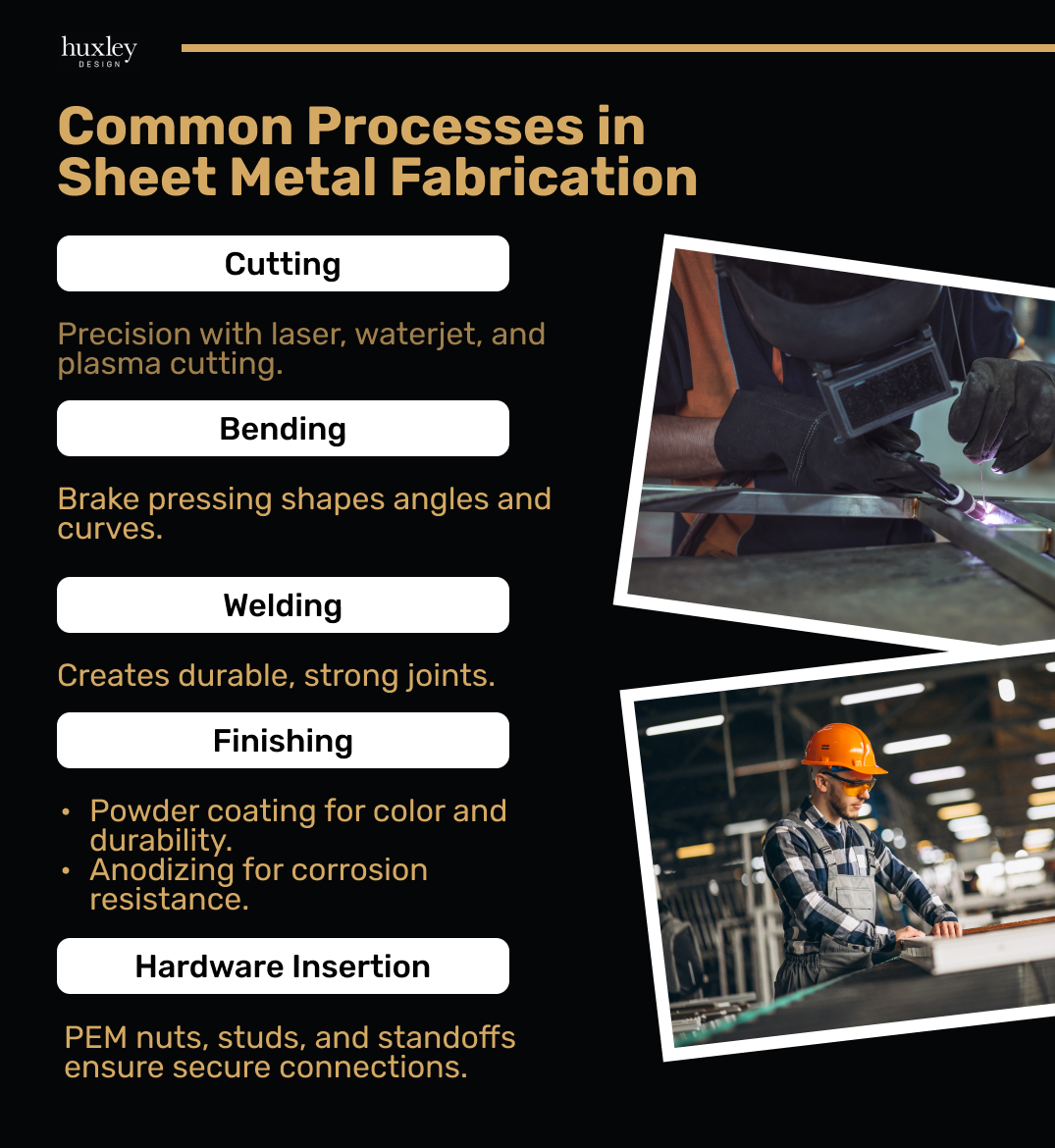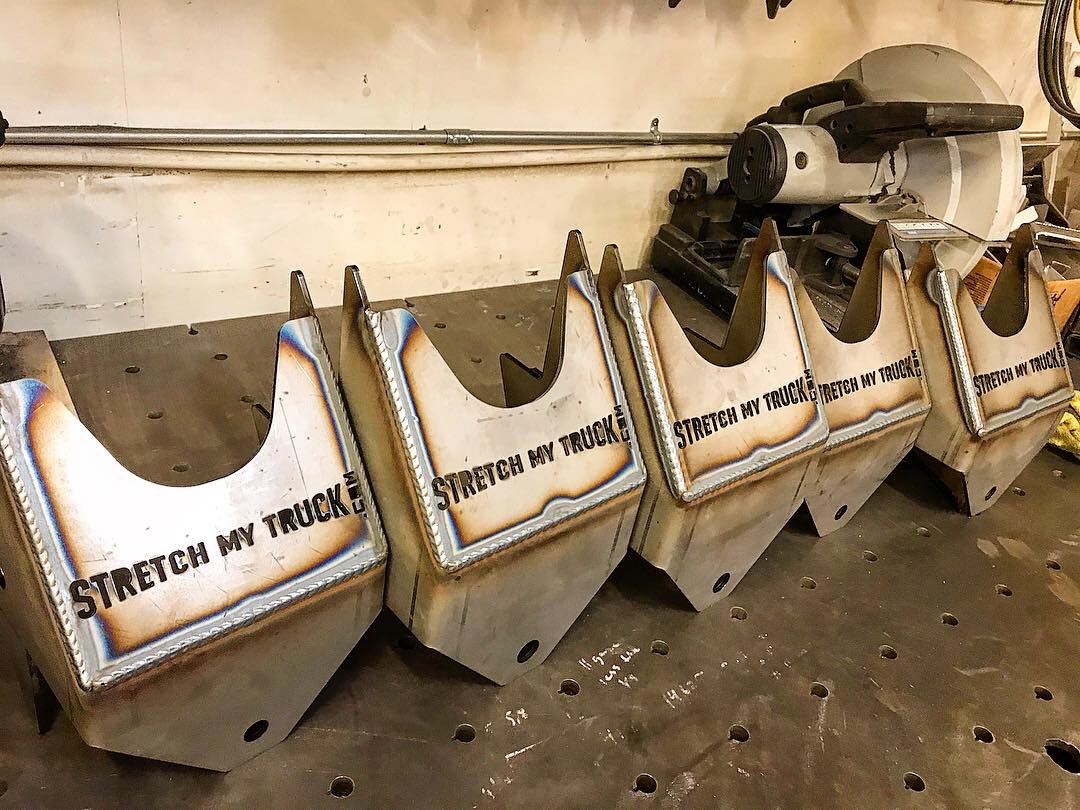Custom sheet metal fabrication is the secret behind some of the most innovative designs around us. From sleek architectural structures to sturdy industrial components, it shapes the way we build and create. It’s a process that combines precision and creativity to turn flat metal sheets into unique, functional designs.
Imagine crafting something truly one-of-a-kind—something tailored to your exact needs. Custom sheet metal fabrication makes this possible by delivering designs that fit perfectly and work flawlessly. Whether it’s a decorative piece or a vital machine part, the possibilities are endless when the right expertise and tools come together.
Table Of Contents:
- Understanding Custom Sheet Metal Fabrication
- Designing for Custom Sheet Metal Fabrication
- From Prototype to Production
- Custom Sheet Metal Fabrication: Real World Examples
- How Huxley Design Leads in Custom Sheet Metal Fabrication
- FAQs about Custom Sheet Metal Fabrication
- Conclusion
Understanding Custom Sheet Metal Fabrication
Custom sheet metal fabrication serves many industries and creates countless products. Businesses rely on quality parts delivered.
The Many Uses of Sheet Metal
Consider everyday objects like electronics and appliances. Cars, airplanes, and the aerospace industry depend on sheet metal. It forms the foundation of entire sectors.
The construction industry relies on these techniques. Architects utilize it for modern designs, often choosing from many material finishes. In 2014, sheet metal fabrication in the US generated over $40 billion.
Common Sheet Metal Processes

Precise metal cutting is achieved through processes like laser cutting and waterjet cutting. Bending, through techniques like brake pressing, creates angles and curves in sheet metal parts. Frequently asked questions surround plasma cutting, which is also a common cutting process.
Welding creates strong joints. Finishing options include powder coating for color and durability. Anodizing and other finishing options protect against corrosion.
Hardware insertion, including PEM nuts, studs, and standoffs, ensures secure connections. These small components play an essential role for hardware operations.
Designing for Custom Sheet Metal Fabrication
Good design is crucial, not just for the final product, but for all steps of fabrication. Even for something like aircraft sheet metal repairs, a solid design is essential. Consider finishing options anodizing as you make your selections for material and material finish.
Start with the Basics
Before starting custom sheet metal fabrication, consider the fundamentals of sheet metal design. This includes selecting sheet metal materials, determining thickness (gauge), calculating bending allowances, hole sizes, and edge distances. There are frequently asked questions about cad files for this stage.
Think about which metal is best. Material properties dictate which metal suits a particular function or structure.
| Material | Properties | Ideal Applications |
|---|---|---|
| Aluminum | Lightweight, corrosion-resistant | Electronics enclosures, automotive panels |
| Stainless Steel | Strong, durable, resists rust | Medical equipment, architectural facades |
| Copper | Conductive, malleable | Electrical components, plumbing fixtures |
Determine the metal’s thickness based on strength requirements. Planning bend locations, hole sizes, and edge finishing is vital to the custom sheet metal fabrication design process. Asking questions such as how much does custom metal work cost and what is a cost-effective sheet metal fabrication choice?
Choosing the Right Fabrication Partner
Finding the right fabrication partner for custom sheet metal fabrication might require research but streamlines the fabrication process. Customer service should also be considered.
Consider several factors. Balance the fabricator’s skill with their pricing, efficiency, adherence to regulations, and lead times.
From Prototype to Production
Sheet metal fabrication involves many steps. First comes design and finding the right sheet metal fabricator, or, metal material supplier.
The Prototype Phase
The process usually begins with CAD (computer-aided design). Experts create detailed 2D and 3D files. Prototyping, with the help of a CAD file and a skilled metal fabricator, lets you refine fit and function before production.
This is a crucial step, allowing you to test and avoid costly mistakes.
Production
After prototype testing and final adjustments, production begins. Both parts and sheet metal repairs, large or small, can then proceed.
Custom Sheet Metal Fabrication: Real World Examples
Custom sheet metal fabrication is central to many industries. Specific examples demonstrate its value.
Automotive manufacturing has utilized sheet metal techniques since Leonardo da Vinci’s early design in 1485.
Architectural projects also rely on sheet parts. From simple to complex designs, architects and designers create facades, staircases, and decorative screens. Even artists utilize these techniques for installations.
How Huxley Design Leads in Custom Sheet Metal Fabrication
At Huxley Design, custom sheet metal fabrication is at the heart of everything we do. We take pride in transforming raw materials like steel, aluminum, and stainless steel into innovative and functional designs that meet your specific needs. Our services reflect our commitment to precision, creativity, and quality.
Here’s how we excel:
1. Cutting-Edge Laser Cutting
We specialize in fiber optic laser cutting, a process that allows us to create intricate and highly detailed designs with precision. This ensures every project is crafted with the utmost accuracy, no matter how complex. From decorative panels to industrial components, our laser cutting technology ensures clean, sharp edges that make your designs stand out.

2. Precise Bending with Press Brake Machines
Shaping metal into specific forms is a key step in custom sheet metal fabrication, and we use advanced press brake machines to achieve this. Our machines bend and form metal into the exact dimensions and shapes you need for your project. This ensures that all components fit seamlessly into their intended application, whether it’s for machinery, furniture, or architectural designs.
3. Expert Welding for Strength and Stability
Our experienced welders bring metal parts together with precision and durability in mind. Whether it’s assembling structural components or joining decorative pieces, our welding techniques create products that are not only functional but built to last.
4. Durable Powder Coating Finishes
To protect your custom metal designs and enhance their appearance, we offer powder coating services. This finishing process adds a tough, durable layer to the surface, ensuring your product can withstand wear and tear while maintaining a polished, professional look.
How Our Services Support Innovative Design
Our ability to customize every aspect of sheet metal fabrication empowers clients to think outside the box. By tailoring every product to your unique needs, we bring your creative visions to life. From custom brackets for machinery to decorative architectural pieces, our team works closely with you to ensure the final product not only looks amazing but performs as required.
Why Choose Huxley Design for Your Custom Fabrication Needs
Here’s what sets us apart:
- Tailored Solutions: We focus on your specific needs, delivering designs and products that are as unique as your project.
- Skilled Team: Our professionals bring expertise and creativity to every stage of fabrication, ensuring top-notch results.
- State-of-the-Art Tools: From laser cutting to powder coating, we use the latest tools and techniques to ensure precision and quality.
- Commitment to Excellence: We take pride in our attention to detail, timely project delivery, and dedication to customer satisfaction.
FAQs about Custom Sheet Metal Fabrication
How much does custom metal work cost?
Costs depend on several factors. Material choices, processes used, part complexity, dimensions, tolerances, and quantity all influence pricing.
Some companies offer hourly rates for custom projects. Many base pricing on individual requests.
What are the three 3 types of metal fabrication?
The three main categories are cutting, forming, and assembly. These include various subtractive techniques for joining metal and additional processes like welding and hardware connections. Learn more with frequently asked questions about laser cut parts, how laser cutting is also sometimes known as cutting laser cutting, or cutting laser, and laser cutting laser for complex geometries or even just making simple parts.
What is custom sheet metal fabrication?
It uses processes like cutting, bending, and assembling to create specific designs. It’s distinct from mass production. Custom fabrication produces customized products for small, short runs.
Larger production runs require different manufacturing methods.
How do you calculate sheet metal fabrication cost?
Material prices, labor costs, and overhead all contribute. Overhead includes factors like production time, facility costs, equipment expenses, and general operating costs.
Conclusion
Custom sheet metal fabrication plays a vital role in shaping innovative designs, from practical industrial components to stunning architectural features. With precise processes like cutting, bending, welding, and finishing, it transforms raw metal into tailored creations that are functional and unique. Whether for small prototypes or full-scale production, the potential of this craft is unmatched when handled by skilled experts.
At Huxley Design, we bring your ideas to life through our expertise in custom sheet metal fabrication. With cutting-edge tools, a dedicated team, and a commitment to quality, we ensure every project is crafted with precision and care. Consult with us today and discover how we can bring precision and creativity to your next project!



Recent Comments